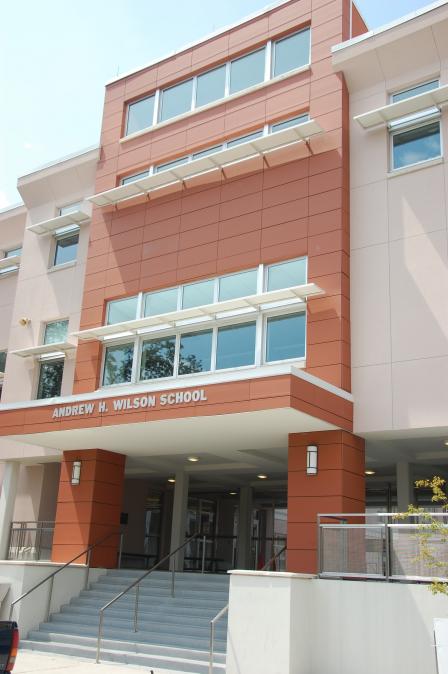RHC for Schools
- About this sector
- Sector opportunities and challenges for project development
- Costs of RHC technologies
About This Sector
In 2003, the United States “education” sector—including pre-kindergarten, K-12 schools, and colleges and universities—comprised about 386,000 buildings with nearly 10 billion square feet of floor space.1 These buildings used more than 525 trillion Btu of energy for heating and cooling applications:2
- 389 trillion Btu for space heating
- 79 trillion Btu for space cooling
- 57 trillion Btu for water heating
Sector Opportunities and Challenges for Project Development

Credit: Joe Ryan, NREL 19648
- They tend to have predictable and well defined space heating, space cooling, and water heating energy loads. Some buildings have hot water loads related to food service operations, laundry, and janitorial services, as well as pool heating needs.
- They often have ample space for siting renewable heating and cooling projects, such as rooftops for solar collectors, playgrounds or parking lots for subsurface geothermal ground loops, and easily accessible areas for biomass fuel storage and handling equipment.
- Renewable heating and cooling systems can generally be easily integrated into the building’s existing heating and cooling infrastructure. For example, schools that currently operate solid fuel-fired boilers may be able to consider biomass as an alternative fuel for space or water heating needs.
- This sector can often take a longer-term investment perspective as a result of its typical stature and longevity within the community. Many educational institutions have been operating for decades and are likely to remain in operation for 20 or more years into the future.
- Educational institutions tend to take interest in combining their educational mission with the technology and economic aspects of renewable project development.
Renewable heating and cooling projects in this sector also face some challenges:
- Because buildings in this sector tend to not be in use or in session year-round, their heating and cooling loads do not always align well with certain renewable technology applications. For example, solar water heating collectors will produce most of their heat during the summer months, when hot water loads are generally at their least due to school being out of session.
- This sector can be highly budget-constrained and can have difficulty paying the high upfront costs associated with renewable heating and cooling projects.
- Many buildings in the education sector were built before the 1980s and are considered “middle-aged” by existing building standards. These buildings may require additional structural enhancements to accommodate certain renewable technology applications that the buildings were not originally designed for.
- Because many educational institutions are non-profit, they may be unable to take advantage of tax-based incentives and depreciation schedules afforded to commercial taxable entities.
Costs of RHC Technologies
The total cost of developing renewable heating and cooling systems can vary based on a number of factors, including the state policy environment, physical geography, available incentives, labor rates, and more. The following cost information is sourced from the National Renewable Energy Laboratory (NREL)3 and should not be interpreted as statistically accurate or sector-specific, but instead should be taken only as rule-of-thumb information and used only for a first-pass screen of economic viability. Visit NREL's website for more detailed information about other costs and typical project lifetimes.
| Technology type | Mean installed cost ($ per square foot) |
Installed cost range (+/- $ per square foot) |
Operation and maintenance cost |
|---|---|---|---|
| Solar water heating: flat-plate and evacuated tube collectors |
$141 | $82 | 0.5 to 1.0% of initial installed cost |
| Solar water heating: plastic polymer collector (unglazed) |
$59 | $15 | 0.5 to 1.0% |
| Technology type | Mean installed cost ($ per ton) |
Installed cost range (+/- $ per ton) |
Operation and maintenance cost |
|---|---|---|---|
| Ground source heat pump | $7,518 | $4,164 | $109 +/- $94 |
| Technology type | Mean installed cost* ($ per kilowatt) |
Installed cost range (+/- $ per kilowatt) |
Fixed operation and maintenance cost ($ per kilowatt) |
|---|---|---|---|
| Biomass wood heat* | $600 | $361 | $91 +/- $33 |
*Biomass wood heat converted from thermal energy capacity (Btu per hour)
- Learn more about solar, geothermal, and biomass technologies.
- Learn more about financial incentives for RHC.
1 U.S. Energy Information Administration. 2008. 2003 Commercial Buildings Energy Consumption Survey. Table B1. Summary Table: Total and Means of Floorspace, Number of Workers, and Hours of Operation for Non-Mall Buildings, 2003.
2 U.S. Energy Information Administration. 2008. 2003 Commercial Buildings Energy Consumption Survey. Table E1. Major Fuel Consumption (Btu) by End Use for Non-Mall Buildings, 2003.
3 National Renewable Energy Laboratory. 2013. Distributed Generation Renewable Energy Estimate of Costs. Updated August 2013.
